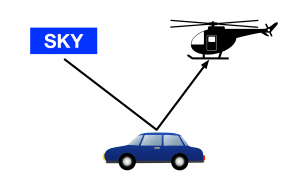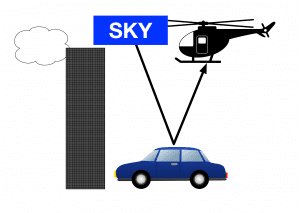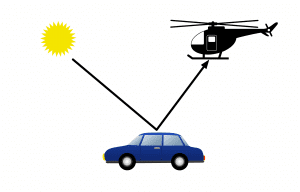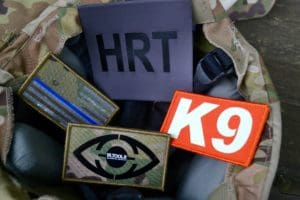- Position
- Weather conditions
- Camera settings
- Foreign substance
 The position of the observer, marker, and reflection affect the visibility of the thermal markers. An ideal situation appears here. There is a clear sky, reflecting its cold temperature off the numbers on the roof of the vehicle.
The position of the observer, marker, and reflection affect the visibility of the thermal markers. An ideal situation appears here. There is a clear sky, reflecting its cold temperature off the numbers on the roof of the vehicle.
 However the image on the left, a building’s temperature is being reflected. With the building in the way, the letters will not look as cold, which will make them less visible.
However the image on the left, a building’s temperature is being reflected. With the building in the way, the letters will not look as cold, which will make them less visible.
In the image on the right the helicopter has adjusted his position so that the sky temperature is reflected again. Trees and buildings are the most likely objects to cause this problem.
Another position issue involves the Sun. When the observer happens to be positioned so the Sun’s temperature is reflected, the markers will appear very hot. In this case the roof may appear hot as well and the markers may get washed out. On the other hand the thermal markers may be very visible, appearing hot on a cooler surface. Moving slightly will fix this problem.
The sky temperature is LOWER when the sky is clear as shown here. The lower sky temperature reflects on the Vehicle Markers, resulting in a greater ΔT (temperature difference) between the marker and the roof of the vehicle. The greater ΔT makes the thermal markers more visible on the roof.
Dark, thick clouds INCREASE the sky temperature. The higher sky temperature reflects on the Vehicle Markers, resulting in a lower ΔT between the marker and the roof of the vehicle. The lower ΔT makes the markers less visible on the roof.
 Tom established IR.Tools™ in 2006, working out of his home for several years before growing into an official office space in 2012. As a veteran and engineer, Tom was led down a path to manufacturer quality infrared markers and insignia for soldiers and military equipment. “My passion for the military, engineering and business leadership all came together in a perfect blend at the perfect time.” An innovator who is always moving forward to stay ahead of the industry, Tom has 15 awarded patents, and 10 patents pending. The Cattis (Calibration Targets for Thermal Weapon Sights) is one of his “babies”, a quick and easy solution for sighting weapons. Tom received his BS and MS in Mechanical Engineering from the University of Maryland, College Park and his MBA from Regents University.
Tom established IR.Tools™ in 2006, working out of his home for several years before growing into an official office space in 2012. As a veteran and engineer, Tom was led down a path to manufacturer quality infrared markers and insignia for soldiers and military equipment. “My passion for the military, engineering and business leadership all came together in a perfect blend at the perfect time.” An innovator who is always moving forward to stay ahead of the industry, Tom has 15 awarded patents, and 10 patents pending. The Cattis (Calibration Targets for Thermal Weapon Sights) is one of his “babies”, a quick and easy solution for sighting weapons. Tom received his BS and MS in Mechanical Engineering from the University of Maryland, College Park and his MBA from Regents University.





